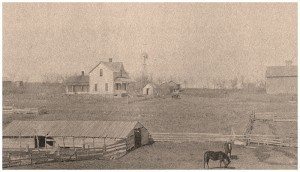Early in the 1870’s, people of Norwegian descent settled in Catherton Township, Webster Co. and Buffalo Township, Franklin Co. As all early settlers did, they selected land along Farmers Creek and Thompson Creek.
Among the earliest settlers were the Erick Erickson (Dahle), Hans Tollefson, G.O. Lee, Jacob and Hans Walstad and Christian Holt. In the 1870’s and 1880’s they were joined by many other families such as, Skjelver, Olson, Arneson, Anderson, Bergman, Banks, Hermanson, Mattison, Arvidson, Pearson and Peterson. Some of these families were not from Norway but, from Sweden and Denmark. Overcrowding and famine were two reasons many left their native land to come to America.

Andrew Erikson's frame house built in 1887 on his homestead, five and one-half miles south of Campbell
Henry Erickson gave the following interview to Donald Danker in an interview dated July 1955. Henry tells of some of the experiences of his parents Andrew and Helena (Tollefson) Erickson, who came to America from Norway in 1864 when they were children.
Andrew Erikson homestead (circa 1887)
Andrew Erikson’s frame house built in 1887 on his homestead, five and one-half miles south of Campbell
“The Erick Erickson and Hans Tollefson families settled in northeast Iowa for a few years, where they had relatives near Decorah, Iowa. In 1868, they decided to try their fortunes farther west. They had heard of some rich homestead lands near Red Cloud and Riverton. The trip was made overland in covered wagons. It was the duty of the children to drive the cattle and horses; Mother was nine years old and her sister, Della, eleven years and they walked every step of the way from Decorah, Iowa to their new home. I have heard them say many times that they did not mind it as long as they were in the open prairies, but, when they had to pass through towns, it was a nightmare. Everyone would torment them and try to stampede the stock. Mother said they camped at Sutton on the Fourth of July and they were sure glad when that day was over.”
“When Dad was about fifteen years old, the family am very poor, so he worked for his board and clothing for a widow lady over on Thompson Creek.
One evening about sundown, a band of Indians pitched their camp near her corn pile. She told Dad to go and tell them that she did not want them to camp there. Dad said his heart was in his throat as he walked a half mile to deliver the message. As soon as he had told them to move, he turned and ran back to the house without even looking back. When he reached the house and did look back, they were all packed and leaving.”
“Dad took a homestead in 1876, as soon as he was twenty-one years old about five miles south of Campbell. In 1882, he was married to Helena Tollefson. Shortly after they were married, he constructed a dugout where they lived until 1887, when he erected a frame house.”
“In the early years of my parent’s wedded life, Dad and Uncle Tom, Mother’s brother, operated a threshing machine. Dad was away from home a good deal of time, which left mother alone. It was not an unusual scene to see buffaloes roaming over the hills.
One day, while Mother was working about the dugout, she noticed it seemed very dark all of a sudden. She turned and looked towards the door and there stood a huge buffalo with nothing between her and the buffalo, except a flimsy screen door.…”
“In the fall of 1883, Dad was threshing up near Juniata when word came to him that he had a son born September 22. Dad unhooked one of the horses from the horse power and jumped astraddle the horse without even unharnessing the horse, waved good-bye to the crew, and started for his dugout about thirty miles away.”
“In the early days, Dad also trucked from Hastings to Riverton. One day he brought a load of flour. He was crossing Thompson Creek, and, as there were no bridges in those times, he had to ford the stream. The rear ingate loosened and, as the team made a lunge to get up the bank, several sacks went into the water. Dad jumped off the wagon and ran down stream to catch the bags as they floated by. When he got to the store in Riverton, he thought he would have to pay for the flour, but the merchant, being a kindly old gentleman, saw that Dad was worried and said, “That’s all right, Andrew. As soon as the sacks dryout there won’t be much loss. There will be just a little flour stick to the sack.”
“The trip to Hastings would take two days. They would drive up one day, put their horses in a livery barn, feed the horses, sleep in the barn, and eat a meal of crackers and cheese or dry bread and bologna.”
“I remember Dad telling about breaking all the farm land of his home and timber claim with a yoke of oxen and an old team of horses. One winter, a snow storm came up and his oxen and team of horses were out foraging in the prairie with the rest of the cattle and with them were a couple of buffalo. When the storm subsided, he went out to look for his stock and found them all dead but the two buffalo. They (buffalo) had milled around and kept on top of the snow while the others had laid down were covered with snow and were smothered.”
